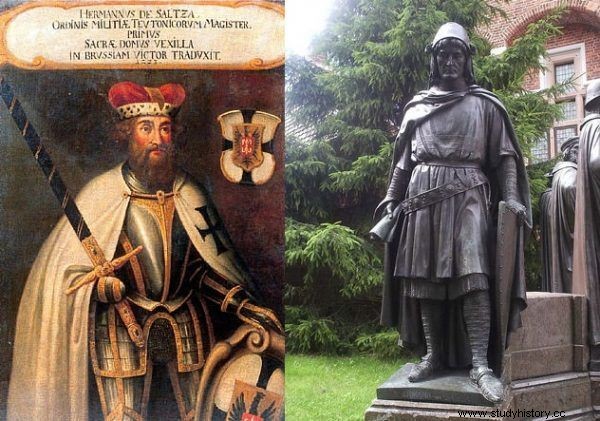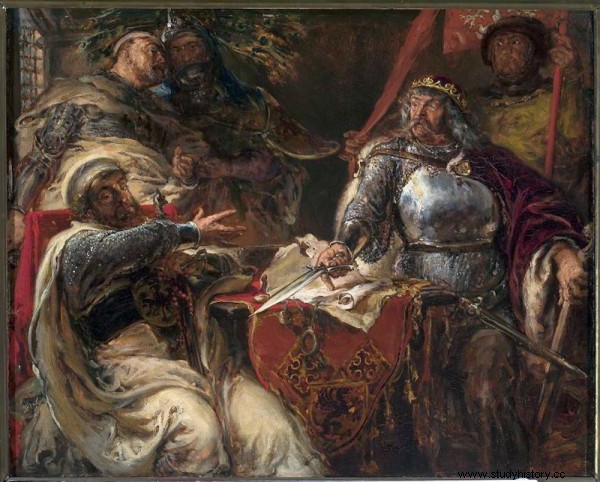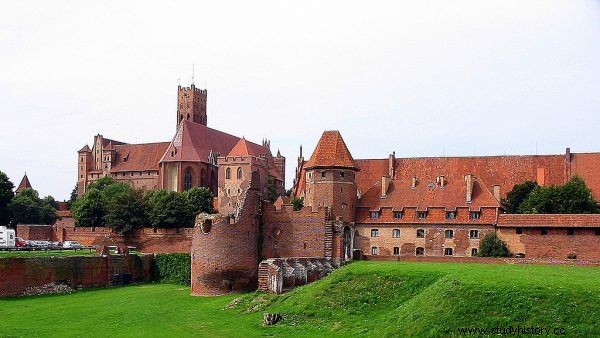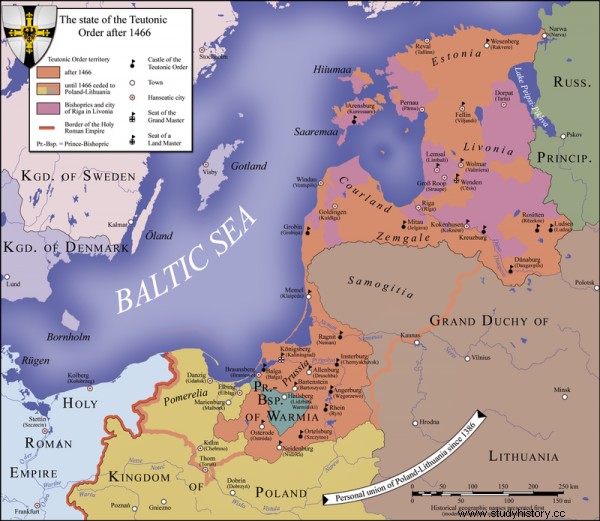The Teutonic Order was one of the three greatest Christian orders of knights. It was created during the crusades in the 11th and 12th centuries. From the lands conquered as a result of "Christianization" he created his own state.
The origins of the order were modest. Here, during the siege of Akka in the Holy Land in 1190, German crusaders and pilgrims founded an association to look after the German knights who were fighting there. Their initiative was supported by the Duke of Swabia, Henry, who handed over the hospital in captured Akka to them.
As the union transformed into a monastic order, donations soon poured in:Pope Clement III granted the Teutonic Knights considerable possessions around Acre, Emperor Henry VI donated lands in southern Italy, and Pope Celestine III exempted the monastic properties from tithing. This beginning was significant:as the future will show, the law will be as effective in defending and spreading the Christian faith as it is in amassing goods, money, and temporal riches. Especially at the expense of those he was supposed to convert .
Masters of getting rich
With time it turned out that the more a new religious organization gains property, financial resources and privileges, the more it wants them. Successive great masters (and especially Hermann von Salza, who lived at the turn of the 12th and 13th centuries) focused on increasing the property of the order, asking the powerful of this world - the pope, emperor, kings and princes - for new grants, tax exemptions and rights. Pope Honorius III alone granted over 100 privileges to the Teutonic Knights.

It was the great master Hermann von Salza who was the actual creator of the order's power. In the picture on the left, a fragment from the German chronicle, in the picture on the right - a monument to the Grand Master at the Teutonic Order Castle in Malbork.
Formally, the Teutonic Knights fought the pagans and defended the Holy Land. In fact, they were building the temporal power of their congregation. In the first half of the 13th century, they already had possessions in the Holy Land, Armenia, Cyprus, Sicily and mainland Italy, as well as in Germany and Hungary . They also made an attempt to create their own state in Europe. However, they gained their real greatness at the expense of the Baltic Prussians, Lithuanians and Poles.
Masters of manipulation
In 1226, Duke Konrad I of Mazovia invited the Teutonic Knights to settle on the Polish-Prussian border. The task of the order was to defend the lands of Mazovia against the repeated Prussian invasions and to Christianize these pagan peoples. Konrad leased the lands of Chełmno and Michałów, which were the basis for the knights' activities. The plan was as follows:the order would conquer the Prussian lands, and then Konrad would incorporate them into his country. But the Mazovian prince miscalculated a bit and underestimated the German brothers….
The Teutonic Knights showed remarkable cleverness and skill in appropriating occupied territories and in properly manipulating evidence and documents to expand their estates. And so, right after the liquidation of the ephemeral order of the Dobrzyń brothers, Christian knights seized the Dobrzyń land that they had occupied and belonged to prince Konrad .
When the enraged prince took all the territories granted to them, the Grand Master obtained from Emperor Frederick II an anti-dated document confirming the granting of the Chełmno and Michałów lands to the order. But not as a lease, but as a perpetual property ... He also gave them ownership of all the lands they would acquire in Prussia. Probably this was not the activity of the Teutonic Knights that Konrad meant when he settled them in his estates ...
Masters of Conquest
The Teutonic Knights did even better in conquering the land of Prussia. What Polish kings and princes have failed to achieve in over 200 years, they have accomplished in five decades. Departing from the Chełmno Land in the 13th century, they conquered in turn:Pomezania, Pogezania, Warmia, Barcja, Natangia, Sambia and Nadrowia, and then Galindia, Skalowia and Jaćwież. By 1249 they had captured Upper Prussia, and by 1283 Lower Prussia and Sambia, i.e. most of the area inhabited by the Prussian tribes.
One by one, they liquidated isolated points of resistance, because the Prusai did not create a centralized state and, even in the face of mortal danger, they were unable to unite. The Teutonic Knights used the scorched earth tactic, destroying Prussian castles and settlements, and quickly building their own strongholds, which allowed the area to be pacified, and were also the base for further expeditions.
The military experience gained in the Middle East, combined with the monastic discipline and high motivation, made the Teutonic knights an ideal military tool. Admittedly, the conquered Prussians started three uprisings, in the years 1242, 1260 and 1276. All of them, however, were bloodily suppressed (though not immediately and not without problems); while the Prusians themselves were killed or turned into a subject. It is estimated that the invaders wiped out 50 percent of the the indigenous people of Prussia . The survivors were used to farm the monastic estates, build castles, fortifications and cities. On the other hand, the Yotvingian tribe was completely killed.
We grab everyone equally
The Teutonic Knights were looking for territorial gains not only in pagan lands. Their greed was great and they did not hesitate to plunder their Christian neighbors . In 1242, due to a conflict over borders, the order's war with the Gdańsk prince Świętopełek broke out. He was concerned about the Teutonic expansion under his side. The monks, with considerable help from the Polish princes - Konrad of Mazovia, his sons Bolesław Mazowiecki and Kazimierz Kujawski, and Bolesław the Pious from Greater Poland - defeated Świętopełek.

Before Łokietek was crowned king of Poland, on the advice of the German prior of the Dominican Order, he asked for help from the Teutonic Knights. Like other Polish princes, it did not do him any good. In the illustration, the painting by Jan Matejko "Łokietek breaks agreements with the Teutonic Knights in Brześć Kujawski".
Helping the Teutonic Knights was a shortsighted policy on the part of the Polish rulers. They did not see the contradiction between their own and the German knights' interests. A conflict soon broke out when Kazimierz (the aforementioned son of Konrad I of Mazovia) wanted to take over some lands conquered by the order, and its expansion into Prussia collided with the expeditions of the Teutonic Knights. Soon the interest of the knights in white coats turned also south, towards Poland. When the Brandenburgians took over Gdańsk Pomerania in 1308, Duke Władysław Łokietek turned to Christian knights for help. These removed the invaders, but then they themselves seized the district and incorporated it into their country .
From then on, a long-lasting Polish-Teutonic conflict began, which lasted until the beginning of the 16th century and left a strong mark on Polish history. During it, the Teutonic Knights organized plundering expeditions to our lands, ravaging, among others, Kujawy and Greater Poland. All the time they also tried to seize more pieces of Polish territory in various ways, for example by buying in 1408 the border strongholds of Drezdenko and Santok from their owners - the lords von Osten.
They were given a pledge for the Dobrzyń land from prince Władysław Opolczyk, and for a temporary pledge for the land of Wizne and Zawkrz by the dukes of Mazovia. In 1317, they bought the land of Michałów from the prince of Inowrocław, Leszek Siemomysłowice, and in 1385 they acquired the land of Tuchom, which was pledged to them by the dukes of Słupsk for an indefinite period.

The Teutonic Knights were still not enough. After the suppression of the Prussian uprisings, their criminal activities escalated. In the years 1283-1325 they invaded Żmudź, Lithuania and Black Ruthenia as many as 75 times. The picture shows the castle in Malbork - the seat of the order until the middle of the 19th century. XV century.
The monastic state expanded in almost all directions. To the west - to get a direct connection with the Reich, which was achieved in 1402 after the purchase of New Marchia. But also to the north, when the Teutonic Knights occupied Gotland in 1398. In 1309, the monastic state had about 40,000 km 2 , and at the beginning of the 15th century already over 72,000 km 2 .
Now Lithuania!
After capturing the Prussian territories, the greedy eyes of the monastic brothers turned to Lithuania. This last pagan state of Europe was perfect for repeating the action that was carried out in Prussia, i.e. the conquest under the noble slogan of the Christianization mission. Therefore, invasions on Żmudź and the neighboring Lithuanian provinces began, burning, killing, looting and capturing the population. Żmudź was particularly important for the order, separating the Teutonic estates in Prussia and Livonia.
During long fights, the German knights managed to capture it twice. From 1283 to 1325, the Teutonic Knights invaded Żmudź, proper Lithuania and Black Ruthenia 75 times . Lithuanian expeditions were a permanent element of the monastic calendar. A great four-week long "cruise" (that is, an armed expedition against pagans) was held every year, and knights from Western Europe were invited to attend. Being baptized by Lithuania did not prevent them from continuing their invasions, because Christianization was only a pretext. It was really about territorial gains, material wealth and population.
Blood money
In the conquered pagan lands, the Teutonic Knights vigorously created their own state. They quickly built wooden strongholds, which they later rebuilt into brick castles; they founded villages and towns, where they brought settlers from Germany. They turned out to be as good administrators and tax collectors as soldiers. The monks were forbidden to engage in trade, but the clever Teutonic Knights received a dispensation from the Pope .
In the mid-fourteenth century, the Teutonic trade flourished, and the activity of the order in this field was clearly aimed at amassing enormous wealth. Grain, amber, flax and wood products were exported. The order enjoyed the privileges of the Hanseatic League (i.e. the union of trading cities of Northern Europe), although it did not belong to it itself. Over time, import and transport trade came to be exported. Teutonic trade agents operated in Lithuania, Mazovia, Ruthenia, Hungary, England and Flanders. France, Scotland, Scandinavian countries as well as Spain and Portugal .
Profits from trade and taxes (high!) Were used by the brothers for the purposes of politics and wars; They spent the rest for the profitable purchase of rents, land and houses, and the establishment of industrial workshops (e.g. mills or sawmills), and finally, like a bank, they dealt with loans. The Order had a monopoly on the trade in amber (severe penalties for breaking it) and grain.
"No private person could trade in Prussia with such capital that the order had at its disposal," wrote the historian of the Teutonic state, Karol Górski. The conquered Prussian population could not move to the cities and be employed there, because the Teutonic Knights needed them to work in their farms. They also pursued a clever monetary policy - they smashed thin bracteates with little silver content . This allowed them to release large amounts of currency needed to finance the construction of castles, fortresses and cities, and of course, waging wars.

The Teutonic Knights did not make money from "converting" the pagans, as they created a real kingdom. The illustration shows a map showing the extent of the state of the Teutonic Order in the mid-15th century.
Thus, in less than a century, the Teutonic Knights created a large, strong, well-developed and important European state out of nothing. They did this by combining military, diplomatic and administrative skills with ruthlessness, fraud and violence. Their state was built on the suffering of peoples who were to convert to the "real" faith:Prusai, Yotvingians, Lithuanians. However, they did not spare their Christian neighbors:Pomeranians, Mazovians and Poles. Huge money gathered in Teutonic trunks in Malbork, Elbląg and Königsberg ran down with blood .
***
Innovative, original novel by Tomasz Stężała " War of the Gods ”Sheds a whole new light on key medieval conflicts in the northern outskirts of Poland. The author not only breaks with the legend of the Teutonic Knights created by Henryk Sienkiewicz, but also debunks the myth of primitive, clad in Prussian pagans. The year 1237, the time of the action, turns out to be a landmark in this bloody game.
